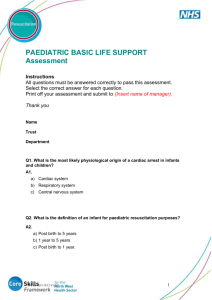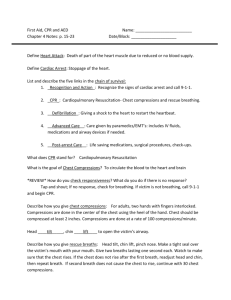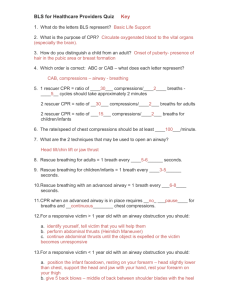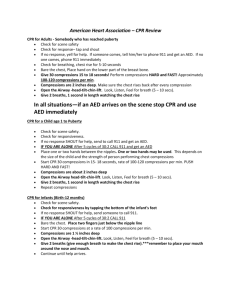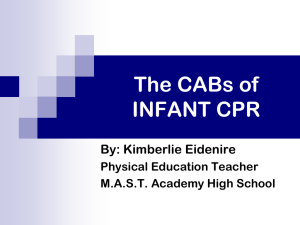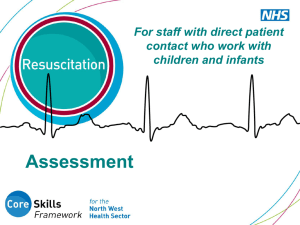Heartsaver/ Pediatric CPR Review Guide
advertisement
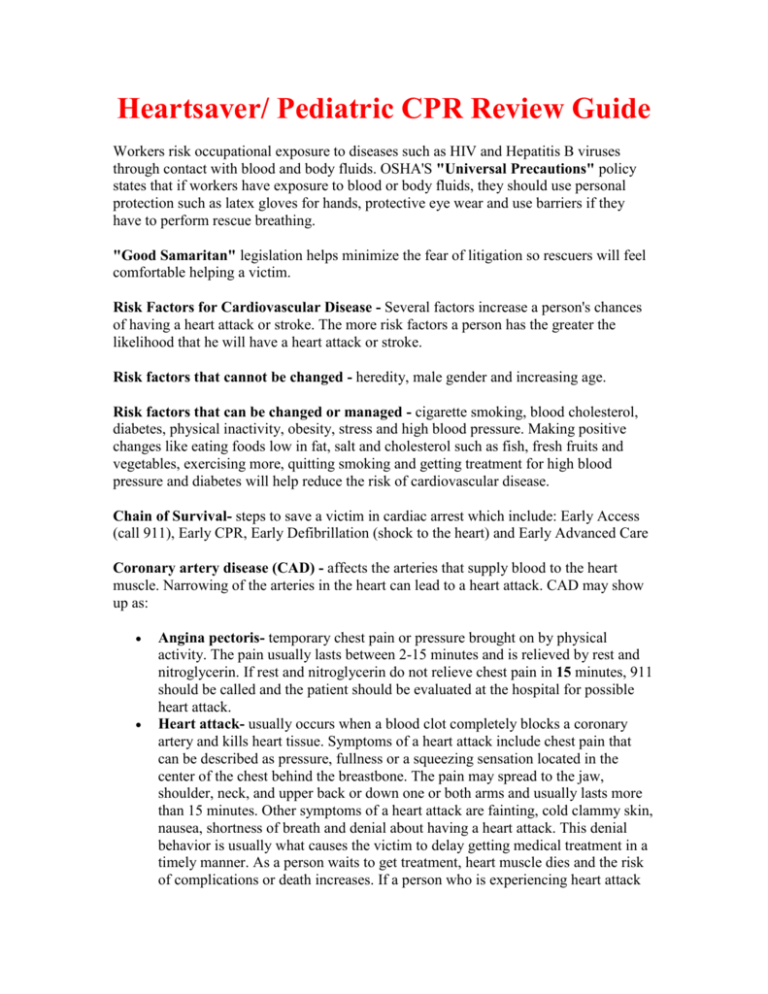
Heartsaver/ Pediatric CPR Review Guide Workers risk occupational exposure to diseases such as HIV and Hepatitis B viruses through contact with blood and body fluids. OSHA'S "Universal Precautions" policy states that if workers have exposure to blood or body fluids, they should use personal protection such as latex gloves for hands, protective eye wear and use barriers if they have to perform rescue breathing. "Good Samaritan" legislation helps minimize the fear of litigation so rescuers will feel comfortable helping a victim. Risk Factors for Cardiovascular Disease - Several factors increase a person's chances of having a heart attack or stroke. The more risk factors a person has the greater the likelihood that he will have a heart attack or stroke. Risk factors that cannot be changed - heredity, male gender and increasing age. Risk factors that can be changed or managed - cigarette smoking, blood cholesterol, diabetes, physical inactivity, obesity, stress and high blood pressure. Making positive changes like eating foods low in fat, salt and cholesterol such as fish, fresh fruits and vegetables, exercising more, quitting smoking and getting treatment for high blood pressure and diabetes will help reduce the risk of cardiovascular disease. Chain of Survival- steps to save a victim in cardiac arrest which include: Early Access (call 911), Early CPR, Early Defibrillation (shock to the heart) and Early Advanced Care Coronary artery disease (CAD) - affects the arteries that supply blood to the heart muscle. Narrowing of the arteries in the heart can lead to a heart attack. CAD may show up as: Angina pectoris- temporary chest pain or pressure brought on by physical activity. The pain usually lasts between 2-15 minutes and is relieved by rest and nitroglycerin. If rest and nitroglycerin do not relieve chest pain in 15 minutes, 911 should be called and the patient should be evaluated at the hospital for possible heart attack. Heart attack- usually occurs when a blood clot completely blocks a coronary artery and kills heart tissue. Symptoms of a heart attack include chest pain that can be described as pressure, fullness or a squeezing sensation located in the center of the chest behind the breastbone. The pain may spread to the jaw, shoulder, neck, and upper back or down one or both arms and usually lasts more than 15 minutes. Other symptoms of a heart attack are fainting, cold clammy skin, nausea, shortness of breath and denial about having a heart attack. This denial behavior is usually what causes the victim to delay getting medical treatment in a timely manner. As a person waits to get treatment, heart muscle dies and the risk of complications or death increases. If a person who is experiencing heart attack symptoms tries to deny there is a problem and is having symptoms of a heart attack, the rescuer should go ahead and activate EMS and monitor the patient until they arrive. Stroke - results from the blockage or rupture of an artery in the brain. Symptoms include: intense headache of sudden onset, facial, arm or leg weakness or numbness, double vision or loss of vision, especially in one eye, difficulty walking, talking, swallowing or loss of consciousness. Treatment is the same as for heart attack. If symptoms persist for more than 15 minutes, activate EMS and stay with the patient until they arrive. High blood pressure is the number one risk factor for stroke. Infant and Child Safety - the most common causes of fatal injuries in infants, children and adolescents include motor vehicle crashes, bicycle-related head injuries, burns or smoke inhalation, falls, toy injuries and drowning. No environment is totally safe. Prevention is the key to protecting children from accidents and injuries. Never leave children unattended. Motor Vehicle & Traffic Safety - Motor vehicle accidents are the number 1 preventable cause of death in children. The back seat is the best seat for children 12 years or younger. No infants or children in car seats should be placed in the front seat of a car with a passenger-side air bag. Guidelines for proper restraint of children in cars are: Infants less than 20 lbs.- use rear-facing car seats in the back seat. Infants more than 20lbs-4year old children-use car seats in the back seat. Children over 4yrs-adults-Use lap and shoulder belts. Booster seats may be needed for 4-7 yr. olds. Call Auto safety hotline at 1-800-424-9393 if you have questions about children and airbag safety. Children riding bicycles should always wear helmets to protect from head injuries. Burns & Smoke Inhalation - Most indoor burns are caused by scalding from hot liquids. Hot water heaters should be between 120F-130F. Each level of the building should have a smoke detector. Never leave a child unattended while cooking, bathing or ironing. Falls - The most frequent cause of injuries in children under 6. Falls occur out of cribs, on stairs, and from falling out of windows. Check cribs to make sure they meet government standards for safety. Provide lighting, remove toys, tack down loose carpet & use gates to protect children from falling on stairs or out of windows. Toy injuries - Most injuries from toys occur when children fall over, choke on pieces or get hit with the toy. Be sure the toy is age appropriate. Don't leave toys lying on ground. And again, supervise children as they play with toys. Major changes in the 2010 guideline recommendations for lay rescuers are the following: 1. If alone with an unresponsive infant or child, give about 5 cycles of compressions and ventilations (about 2 minutes) before leaving the child to phone 911. 2. Do not try to open the airway using a jaw thrust for injured victims-use the head tilt-chin lift for all victims. 3. Take 5-10 seconds (no more than 10 seconds) to check for normal breathing in an unresponsive adult or for presence or absence of breathing in the unresponsive infant or child. 4. Take a normal (not a deep) breath before giving a rescue breath to a victim. 5. Give each breath over 1 second. Each breath should make the chest rise. 6. If the victim’s chest does not rise when the first breath is delivered, perform the head tilt-chin lift again before giving the second breath. 7. Do not check for signs of circulation. After delivery of 2 rescue breaths, immediately begin chest compressions (and cycles of compressions and rescue breaths). 8. No teaching of rescue breathing without chest compressions (exception: rescue breathing is taught in the Heartsaver/Pediatric First Aid Course). 9. Use the same 30:2 compression-to-ventilation ratio for all victims. 10. For children, use 1 or 2 hands to perform chest compressions and compress at the nipple line; for infants, compress with 2 fingers on the breastbone just below the nipple line. 11. When you use an AED, you will give 1 shock followed by immediate CPR, beginning with chest compressions. Rhythm checks will be performed every 2 minutes. 12. Actions for relief of choking (severe Airway obstruction) have been simplified. 13. New first aid recommendations have been developed with more information included about stabilization of the head and neck to injured victims. Action Steps for Adult CPR: Make sure the scene is safe. Make sure the victim is lying on his back on a firm, flat surface. If the victim is facedown, carefully roll him onto his back. Kneel at the victim’s side. Tap and shout to see if the victim responds. If the victim does not respond, yell for help. If someone comes, send that person to phone 911 and get the AED. If no one comes, leave the victim to phone 911 and get the AED. Return to the victim and start the steps of CPR. Open the airway with a head tilt-chin lift. Check to see if the victim is breathing normally (take at least 5 seconds but no more than 10 seconds). Put your ear next to the victim’s mouth and nose. Look to see if the chest rises. Listen for breaths. Feel for breaths on your cheek. If there is no normal breathing, give 2 breaths (1 second each). Watch for the chest rise as you give each breath. Quickly move or remove clothes from the front of the chest that will get in the way of doing compressions and using an AED. Give 30 compressions at a rate of at least 100 a minute and then give 2 breaths. After each compression, release pressure on the chest to let it come back to its normal position. Keep giving sets of 30 compressions and 2 breaths until the AED arrives, the victim starts to move, or trained help takes over. Action Steps for Child CPR (1-8 year old) Make sure the scene is safe. Make sure the victim is lying on her back on a firm, flat surface. If the victim is lying facedown, carefully roll her onto her back. Kneel at the victim’s side. Tap and shout to see if the victim responds. If the victim does not respond, yell for help. If someone comes, send that person to phone 911 and get the AED. If no one comes, stay with the child and start the steps of CPR. Open the airway with a head tilt-chin lift. Check to see if the victim is breathing (take at least 5 seconds but no more than 10 seconds). Put your ear next to the victim’s mouth and nose. Look to see if the chest rises. Listen for breaths. Feel for breaths on your check. If the child is not breathing, give 2 breaths (1 second each). Watch for the chest rise as you give each breath. Quickly move or remove clothes from the front of the chest that will get in the way of doing compressions and using an AED. Give 30 compressions at a rate of 100 a minute and then give 2 breaths. After each compression, release pressure on the chest to let it come back to its normal position. After 5 sets of 30 compressions and 2 breaths, if someone has not done this, phone 911 and get an AED. Return to the child and start the steps of CPR. Keep giving sets of 30 compressions and 2 breaths until an AED arrives, the victim starts to move, or trained help takes over. Action Steps for Infant CPR (Birth to 1 year of age) Make sure the scene is safe. Tap the infant’s foot and shout to see if the infant responds. If the infant does not respond, yell for help. If someone comes, send that person to call 911. If no one comes, stay with the infant to start the steps of CPR. Place the infant on a firm, flat surface. If possible, place the infant on a surface above the ground, such as a table. Open the airway with the head tilt-chin lift. Check to see if the infant is breathing (take at least 5 seconds but no more than 10 seconds). Put your ear next to the infant’s mouth and nose. Look to see if the chest rises Listen for breaths. Feel for breaths on your cheek. If the infant is not breathing, give 2 breaths (1 second each). Watch for the chest rise as you give each breath. Quickly move or open clothes from the front of the chest that will get in the way of doing compression. Give 30 compressions at a rate of 100 a minute and then give 2 breaths. After each compression, release pressure on the chest to let it come back to its normal position. After 5 sets of 30 compressions and 2 breaths, if someone has not done this find a phone and call 911. Begin the steps of CPR. Keep giving sets of 30 compressions and 2 breaths until the infant starts to move or trained help takes over. Action Steps for Choking Victims over the age of 1 year old If you think someone is choking, ask, “Are you choking?” If he nods, tell him you are going to help. Kneel or stand firmly behind him and wrap your arms around him so that your hands are in front. Make a fist with one hand. Put the thumb side of your fist slightly above his navel (belly button) and well below the breastbone. Grasp the fist with your other hand and give quick upward thrusts into his abdomen. Give thrusts until the object is forced out and he can breathe, cough or talk or until he stops responding. Action Steps for a choking victim who stops responding (over the age of 1 year old) Yell for help. If someone comes, send them to call 911 and get an AED. Lower the victim to the ground, face up. If you are alone with the adult victim, phone 911 and get an AED. Then return to the victim and start the steps of CPR. If you are alone with the child victim, start the steps of CPR. Every time you open the airway to give breaths, open the victim’s mouth wide and look for the object. If you see an object, remove it with your fingers. If you do not see an object, keep giving sets of 30 compressions and 2 breaths until an AED arrives, the victim starts to move, or trained help takes over. After about 5 cycles or 2 minutes, if you are alone, leave the child victim to call 911 and get an AED. Return to the child and continue the steps of CPR. Action Steps to help a choking large person or pregnant woman. If the choking victim is in the late stages of pregnancy or is very large, use chest thrusts instead of abdominal thrusts. Follow the same steps as above except for where you place your arms and hands. Put your arms under the victim’ armpits and your hands on the center of the victim’s chest. Pull straight back to give the chest thrusts. Action Steps to help a choking infant (birth to 1 year old) Hold the infant facedown on your forearm. Support the infant’s head and jaw with your hand. Sit or kneel and rest your arm on your lap or thigh. Give up to 5 back slaps with the heel of your free hand between the infant’s shoulder blades. If the object does not come out after 5 back slaps, turn the infant onto his back. Move or open the clothes from the front of the chest only if you can do so quickly. You can push on the chest through clothes if you need to. Give up to 5 chest thrusts using 2 fingers of your free hand to push on the breastbone in the same place you push for compressions. Support the head and neck. Hold the infant with one hand and arm, resting your arm on your lap or thigh. Alternate giving 5 back slaps and 5 chest thrusts until the object comes out and the infant can breathe, cough, or cry or until the infant stops responding. Action Steps for a choking infant who stops responding Yell for help. If someone comes have them call 911 while you start the steps of CPR. Place the infant on a firm, flat surface. If possible, place the infant on a surface above the ground, such as a table. Start the steps of CPR. Every time you open the airway to give breaths, open the infant’s mouth wide and look for the object. If you see an object, remove it with your fingers. If you do not see an object, keep giving sets of 30 compressions and 2 breaths. Continue CPR until the infant starts to move or trained help takes over. After about 5 cycles or 2 minutes, if you are alone, leave the infant to call 911. Return to the infant and continue the steps of CPR. For a complete listing of the 2005 AHA Guidelines for CPR and ECC consult the winter 2006 edition of Currents or the New Heartsaver CPR or Heartsaver First Aid with CPR textbooks. For information on CPR/First Aid/AED classes call the local chapter of the American Heart Association
